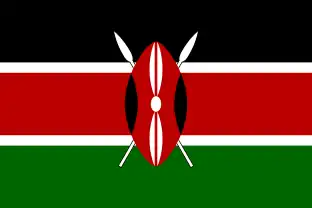Gabra people
The Gabra (Oromo: Gabraa) are related to the wider Oromo people in the Horn of Africa, they mainly inhabit the Moyale and Marsabit regions of northern Kenya and the highlands of southern Ethiopia they mostly practice Islam and Christianity as religion but maintain mandatory cultural practice Ethiopia..[3][4][5][6][7][8]
Gabra | |
|---|---|
| Total population | |
| c. 700,000 | |
| Regions with significant populations | |
| 520,010 (2007)[1] | |
| 141,200 (2019)[2] | |
| Languages | |
| Oromo | |
| Religion | |
| Islam | |
| Related ethnic groups | |
| |
| Part of a series on the |
| Culture of Kenya |
|---|
 |
| Cuisine |
Genetics
According to Y-DNA analysis by Hirbo (2011), around 82.6% of Gabra in Kenya carry the paternal E1b1b haplogroup, with most belonging to the V12 or E3b1a subclade (58.6%). This lineage is most common among local Afroasiatic-speaking populations. The remaining Gabra individuals bear the T/K2 (3.4%) and J haplogroups (3.4%), which are both also associated with Afroasiatic speakers, as well as the E3*/E-P2 clade (3.4%) and E2a lineage (3.4%).[9]
Maternally, Hirbo (2011) observed that approximately 58% of the Gabra samples carried derivatives of the Eurasian macrohaplogroups M and N. Of these mtDNA lineages, the M1 subclade was most common, with around 22.58% of the Gabra individuals belonging to it. The remaining ~42% of the analysed Gabra bore various subclades of the Africa-centered macrohaplogroup L. Of these mtDNA lineages, the most frequently borne clade was L3 (19.36%), followed by the L0a (9.68%), L4 (9.68%), and L2 (6.45%) haplogroups.[9]
The Gabra's autosomal DNA has been examined in a comprehensive study by Tishkoff et al. (2009) on the genetic affiliations of various populations in Africa. According to Bayesian clustering analysis, the Gabra generally grouped with other Afroasiatic-speaking populations inhabiting Northern Kenya.[10]
References
- Gordon Jr., Raymond G., ed. (2005). Ethnologue: Languages of the World, Fifteenth Edition. Dallas: SIL International. ISBN 978-1-55671-159-6.
- "2019 Kenya Population and Housing Census Volume IV: Distribution of Population by Socio-Economic Characteristics". Kenya National Bureau of Statistics. Retrieved 24 March 2020.
- Tablino, Paolo (1999). The Gabra: Camel Nomads of Northern Kenya. Paulines Publications Africa. ISBN 978-9966-21-438-6.
- Wairimu, Nderitu, Alice (2018-12-14). Beyond Ethnicism: Exploring Racial and Ethnic Diversity for Educators. Mdahalo Bridging Divides. ISBN 978-9966-1903-0-7.
{{cite book}}: CS1 maint: multiple names: authors list (link) - Whittaker, Hannah (2014-10-13). Insurgency and Counterinsurgency in Kenya: A Social History of the Shifta Conflict, c. 1963-1968. BRILL. ISBN 978-90-04-28308-4.
- Schlee, Günther; Shongolo, Abdullahi A. (2012). Islam & Ethnicity in Northern Kenya & Southern Ethiopia. Boydell & Brewer Ltd. ISBN 978-1-84701-046-9.
- Feyissa, Dereje; Hoehne, Markus V.; Höhne, Markus Virgil (2010). Borders & Borderlands as Resources in the Horn of Africa. Boydell & Brewer. ISBN 978-1-84701-018-6.
- Kefale, Asnake (2013-07-31). Federalism and Ethnic Conflict in Ethiopia: A Comparative Regional Study. Routledge. ISBN 978-1-135-01798-9.
- Hirbo, Jibril B. "Complex Genetic History of East African Human Populations" (PDF). University of Maryland. pp. 195, 199, 215, 220. Retrieved 5 December 2017.
- Sarah Tishkoff; et al. (2009). "The Genetic Structure and History of Africans and African Americans" (PDF). Science. 324 (5930): 1035–44. Bibcode:2009Sci...324.1035T. doi:10.1126/science.1172257. PMC 2947357. PMID 19407144. Archived from the original (PDF) on 2017-08-08. Retrieved 2017-12-05.
- Tablino, Paul (1999): The Gabra: Camel Nomads of Northern Kenya. ISBN 9966-21-438-0
- Kassam, Aneesa (2006): "The People of the Five "Drums": Gabra Ethnohistorical Origins." in Ethnohistory. 53(1):173-193; doi:10.1215/00141801-53-1-173 (PDF)
- Wood, John (1999): When Men Are Women: Manhood Among Gabra Nomads of East Africa. University of Wisconsin Press.
Further reading
- Günther Schlee: Interethnic Clan Identities among Cushitic-Speaking Pastoralists, in: Africa: Journal of the International African Institute, Vol. 55, No. 1 (1985), Edinburgh University Press
- Muchemi Wachira: Neither Ethiopian Nor Kenyan, Just Gabra, Garre Or Borana, in: The East African, 31. August 2009